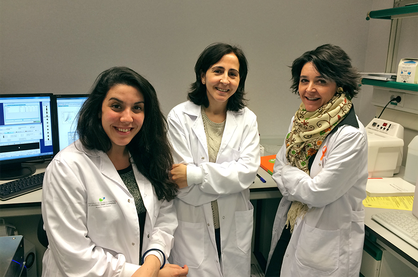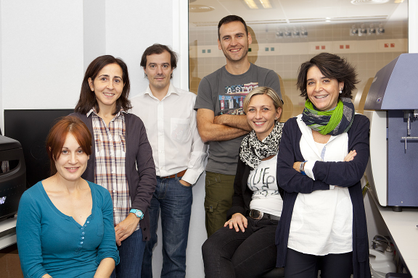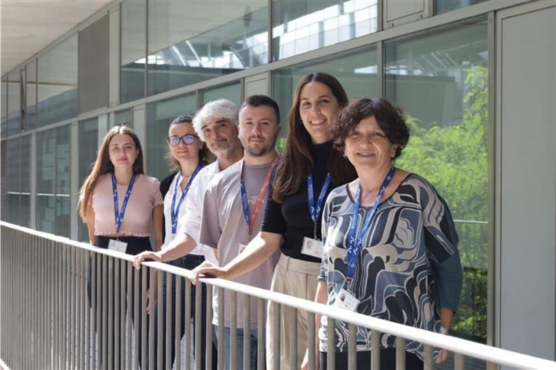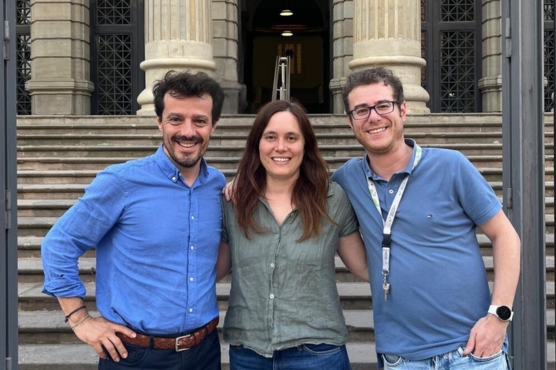This research group from the Josep Carreras Leukaemia Research Institut (University of Barcelona Hospital Clínic Campus), has also described the quantification of hematopoietic cells during human fetal development
Dr. Clara Bueno together with other members of the Stem Cell, Mesenquimal Cancer and Development Research Group at the Hospital Clínic-UB Campus (Alejandra Sanjuan-Pla, Álvaro Muñoz-López and Pablo Menéndez) have led a study, published in the journal Leukemia, describing for the first timethe generation of B1 lymphocytes during blood development. B1 lymphocytes are the “great unknown” and, in addition to playing a significant role in infections, have been associated with leukaemia.
Recently, this research group from the IJC has published other studies. Thus, a new scientific article on infantile acute lymphoblastic leukaemia in cells t (4; 11) / MLL-AF4 + B has been published in the prestigious journal Blood. This particular article, under the direction of Dr. Sanjuan-Pla, focuses on what is known about this form of leukaemia, some of the particular characteristics of studying a disease that appears in such young patients, and goes on to mention what the group hopes will be the result of the application of new technologies in this field of research. (You can read the original article here).
Moreover, Dr. Alessandra Giorgetti has also published a paper in the journal Stem Cell Reports which describes a new way to generate neurons from blood stem cells (these cells give rise to all different types of cells in the blood). Neurons are specialist cells of the nervous system that transmit messages through electrical and chemical signals. The group is interested in generating populations of cells this way in order to use them to study the mechanisms of normal cell development, but also to see what goes wrong when cells turn leukaemic. These cells will provide a valuable resource and a tool to test possible therapies for toxicity and efficacy of new drugs. These studies are essential before a possible treatment can be tried on patients, or even on mice.
What is leukaemia MLL-AF4 +, the type of leukaemia this research group studies?
Very infrequent, unknown in the scientific world, incurable and with prenatal origin. This is the way we could describe acute lymphoblastic leukaemia MLL-AF4+. It is precisely on this very specific type of leukaemia that Dr Pablo Menéndez, director of the UB-Clinic campus at the Josep Carreras Research Institute, has been working on for many years. Dr. Clara Bueno, Dr. Alejandra Sanjuan and Dr. Alessandra Giorgetti are part of his team.
Childhood cancer is very different from cancer in adults. The most recent research indicates that in some cases neoplasms can have prenatal origin and, therefore, appear during pregnancy. Pro-B lymphoblastic leukaemia in lactating infants is incurable today. Dr Menendez’s project intends to improve knowledge on this very bad prognosis paediatric cancer that, because it is not very frequent and affects very few children a year in the world, is not a critical line of investigation for regular funding sources.
Childhood leukaemia with MLL gene rearrangement (a result of genomic translocation 4;11) is characterised by high level resistance to current drugs and 70% of the patients show infiltration into the central nervous system. Said infiltration is probably the highest cause of death in these babies and underlies the lack of response to current therapy.
The main goal of this project at the Josep Carreras Research Institute against Leukaemia is to identify the population phenotype responsible for the invasion of leukemic cells in the central nervous system so as to determine the antigenic profile to which new therapeutic strategies should be addressed. Reaching this goal will no doubt allow the quality of life of these children who suffer from this very aggressive type of leukaemia with an 80% mortality rate after 4-5 years to improve.
The study of this type of leukaemia is especially complicated due to the patients’ young age and the few samples of cells with which to work with. Unlike many other types of cancer there isn’t an animal cellular model for this disease that makes experimenting our new therapeutic strategies possible. Also, there is a surprising genetic stability among these patients, which means there is another unknown factor playing a decisive role.
Today, Dr Menedez’s team is concentrating on creating a cellular model focused on studying the way in which this type of leukaemia develops in detail. At the same time, they are also creating a collection of cells from patients that will provide a lot more information, for the previous studies have been done based on a very small amount of cells.
Even though Dr Menéndez has been working on the project from the UB-Clinic campus at the Josep Carreras Research Institute against Leukaemia for many years now, the European Research Council’s grant will allow the team to intensify the progression of the study of this disease and significantly increase the speed at which they obtain results.








